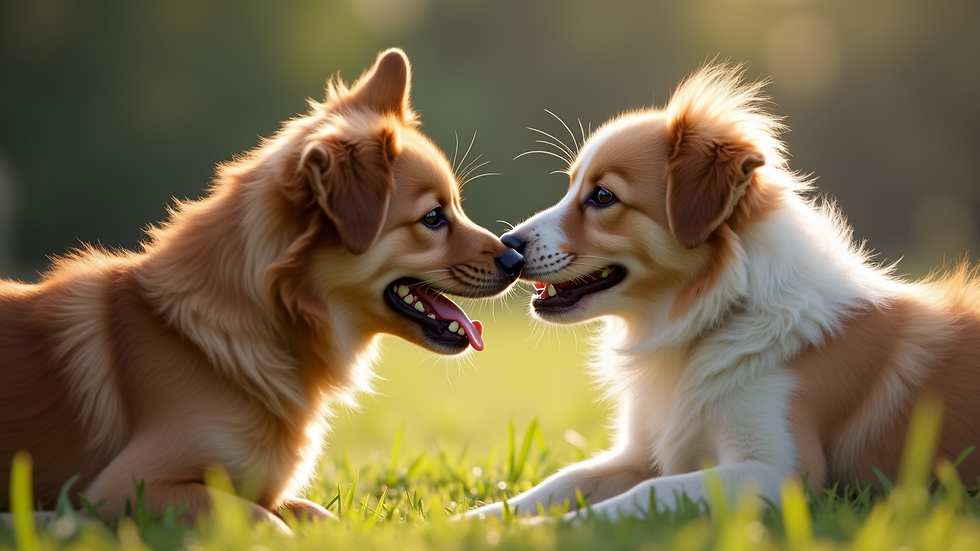Top Techniques to Train Your Dog Effectively
- Jess A

- Jun 2
- 3 min read
Training your dog can be a rewarding experience that strengthens your bond while ensuring your pet is well-behaved. This guide will delve into top techniques that can help you in your dog training journey.
Understanding Dog Training
Dog training involves teaching your dog to understand commands, behave appropriately, and respond positively to human interactions. It's essential for a happy household and community. Whether you have a puppy or an adult dog, the techniques discussed here can be adjusted to suit any age or breed. Here are some effective methods to make your training sessions productive and enjoyable.

Positive Reinforcement in Dog Training
One of the most effective methods of training is positive reinforcement. This technique involves rewarding your dog for good behavior rather than punishing them for bad behavior. The rewards can be treats, verbal praise, or affection. Positive reinforcement encourages your dog to repeat desired behaviors.
For example, when your dog sits on command, offer a treat and say "good boy" in a cheerful voice. Dogs learn faster when they are rewarded immediately after performing the correct action. Statistical data reveals that dogs trained using positive reinforcement are more likely to retain commands and feel more secure in their environment.
Create a structured reward system to help reinforce these behaviors:
High-Value Treats: Use treats that your dog loves especially for training.
Timing: Reward immediately after the desired behavior.
Consistency: Use the same command and reward system consistently.

Setting Clear Commands
Clarity is crucial in dog training. It is essential to use simple and consistent commands when training your pet. Commands like "sit," "stay," and "come" should be clear and distinct. Here are some tips for establishing effective commands:
Single Words: Use one-word commands to avoid confusion.
Tone of Voice: Maintain a firm yet friendly tone. Your dog can sense your attitude through your voice.
Gestures: Include hand signals to accompany verbal commands. This helps dogs understand what is expected more quickly.
Practice makes perfect. Repeatedly reinforce these commands in different environments to help your dog generalize their understanding, making them more reliable.
Socialization Techniques
Socialization is a key component of training. It's important to expose your dog to a variety of people, environments, and other animals. This will help them become well-adjusted and reduce fear-based behaviors. Here are techniques to effectively socialize your dog:
Early Exposure: Start socializing your puppy from a young age. Introduce them to different sights and sounds.
Controlled Meetings: Organize playdates with other dogs who have been vaccinated and are known to be friendly. This helps establish good behaviors in varied environments.
Training Classes: Enroll in group training classes. This setting allows your dog to interact with others while learning essential commands.
Consistent socialization contributes to a well-rounded and confident dog.

Incorporating Fun into Training
Training does not have to be boring for you or your dog. Incorporating fun into your sessions can lead to better retention and stronger bonding. Here are some fun techniques you can use:
Games: Play games that incorporate training commands. For instance, "fetch" can reinforce the "come" command.
Obstacle Courses: Create a small obstacle course in your backyard to make training exciting. This encourages physical exercise and mental stimulation.
Interactive Toys: Utilize interactive toys that require your dog to perform tasks to receive treats.
When your dog associates training with fun, they are likely to engage and respond better during sessions.
Tracking Progress and Adjustments
Monitoring your dog's progress is key to successful training. Keeping track of their achievements and setbacks helps you adapt your techniques as needed. Consider these methods:
Training Journal: Keep a log of commands learned, behaviors improved, and challenges faced. This will help you spot patterns and areas needing adjustment.
Frequency: Adjust the frequency of training sessions based on how quickly your dog picks up commands. If they learn quickly, you can gradually increase the pace.
Feedback: Pay attention to your dog's reactions. If they seem confused or distressed, it may be time to change your approach.
Being flexible and patient is essential in dog training.
Final Thoughts on Effective Dog Training
Training your dog is a journey that requires dedication, patience, and love. Whether you're implementing positive reinforcement, socialization, or fun activities into your sessions, the key is consistency. Remember that the goal of effective dog training is not just obedience but also a happy relationship built on trust.
Invest in your training sessions, and soon you'll enjoy a well-mannered and joyful canine companion. For more comprehensive guidance and personalized strategies, you might want to check out detailed resources on dog training. Happy training!




Comments